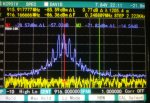doggy
New Member
I need some help!
I am trying to use the Teensy 4.0. Code built and uploaded okay. Connected the CC1101 board.
Teensy 3.5 has SPI clock on pin 14. Teensy 4.0 has it on pin 13.
I changed BoardConfig.h so SCK is 13 not 14. I checked the various arduino header files and they correctly have SCK on 13.
When I run the Teensy, the code sends "Initialising CC1101..." and sits there for ever.
I put a scope onto the various pins and see the CS (Chip Select) change. I also see an output square wave from the GDO0 pin (pin 24 on Teensy) presumably in response to the CS. I also see a brief burst of data on Teensy pin 11 (SPI data from Teensy).
However, there is no clock signal on 13 (nor on 14 for that matter- not that I would expect it there). Pin sits at ground.
Now, the internal LED is apparently connected to Pin 13 on the Teensy and the code suggests MicronetToNMEA outputs status of some sort to the LED.
I am wondering if the LED is being signalled by the code and overriding SCK so that nothing comes out?
It appears that the MtN code reassigns SCL from pin 13 to 14 for Teensy 3.x. However, reassignment to alternate pins is not possible on T4.0. So I need to stick with pin 13, make sure outputs to internal LED do not occur and somehow get clock to appear on pin 13!
Any wisdom would be much appreciated as to how I might overcome this. Presumably the info will be useful for others as well. I did try changing pins_Arduino.h for the LED (#define LED_BUILTIN (32)) to move from pin 13 to 32. No change.
Regds,
David
I am trying to use the Teensy 4.0. Code built and uploaded okay. Connected the CC1101 board.
Teensy 3.5 has SPI clock on pin 14. Teensy 4.0 has it on pin 13.
I changed BoardConfig.h so SCK is 13 not 14. I checked the various arduino header files and they correctly have SCK on 13.
When I run the Teensy, the code sends "Initialising CC1101..." and sits there for ever.
I put a scope onto the various pins and see the CS (Chip Select) change. I also see an output square wave from the GDO0 pin (pin 24 on Teensy) presumably in response to the CS. I also see a brief burst of data on Teensy pin 11 (SPI data from Teensy).
However, there is no clock signal on 13 (nor on 14 for that matter- not that I would expect it there). Pin sits at ground.
Now, the internal LED is apparently connected to Pin 13 on the Teensy and the code suggests MicronetToNMEA outputs status of some sort to the LED.
I am wondering if the LED is being signalled by the code and overriding SCK so that nothing comes out?
It appears that the MtN code reassigns SCL from pin 13 to 14 for Teensy 3.x. However, reassignment to alternate pins is not possible on T4.0. So I need to stick with pin 13, make sure outputs to internal LED do not occur and somehow get clock to appear on pin 13!
Any wisdom would be much appreciated as to how I might overcome this. Presumably the info will be useful for others as well. I did try changing pins_Arduino.h for the LED (#define LED_BUILTIN (32)) to move from pin 13 to 32. No change.
Regds,
David
Last edited:


